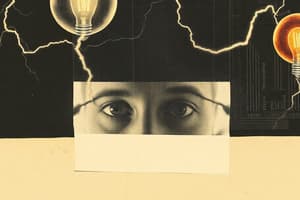Podcast
Questions and Answers
Which materials allow the flow of electric charge through them easily?
Which materials allow the flow of electric charge through them easily?
- Neutral materials
- Induced charges
- Conductors (correct)
- Insulators
What are the two primary types of electric charges?
What are the two primary types of electric charges?
- Positive and negative (correct)
- Negative and neutral
- Positive and neutral
- Neutral and positive
What happens when an insulator is charged?
What happens when an insulator is charged?
- The insulator becomes a conductor
- The charges remain localized at the points of contact (correct)
- The insulator loses its ability to resist electric charge flow
- The electrons move around in the material until the conductor has an equal number of positive and negative charges
What are induced charges?
What are induced charges?
What happens when an electric field is applied to a conductor?
What happens when an electric field is applied to a conductor?
What causes the movement of electrons, which in turn induces electric charges?
What causes the movement of electrons, which in turn induces electric charges?
What is the main difference between static charges and electric current?
What is the main difference between static charges and electric current?
Which type of current is used in power transmission due to its ability to be transmitted over long distances with minimal loss?
Which type of current is used in power transmission due to its ability to be transmitted over long distances with minimal loss?
In which type of circuit are the components connected in a chain, and the current flows through each component in sequence?
In which type of circuit are the components connected in a chain, and the current flows through each component in sequence?
What is the symbol used to represent electric current?
What is the symbol used to represent electric current?
What allows the electrons to flow through the circuit?
What allows the electrons to flow through the circuit?
What is the measurement unit of electric current?
What is the measurement unit of electric current?
Which direction is defined as the direction in which positive charges flow?
Which direction is defined as the direction in which positive charges flow?
Which type of circuit allows the current to flow through each branch independently?
Which type of circuit allows the current to flow through each branch independently?
Flashcards are hidden until you start studying
Study Notes
Electric Charges and Its Effect
Electric charges are separated particles that possess electromagnetic force, which can either be positive or negative. They are induced by the movement of electrons, which is caused by the flow of electric current. In this article, we will discuss the types of electric charges, electric current, and circuits.
Types of Electric Charges
Electric charges can be classified into two primary types: positive and negative. These charges are attracted to each other, and opposite charges repel each other. The following are the sources of electric charges:
-
Conductors: Conductors are materials that allow the flow of electric charge through them easily. When a conductor is charged, the electrons move around in the material until the conductor has an equal number of positive and negative charges.
-
Insulators: Insulators are materials that do not allow the flow of electric charge through them easily. When an insulator is charged, the electrons do not move around in the material, and the charges remain localized at the points of contact.
-
Induced charges: Induced charges are charges that are generated by the movement of an electric field. When an electric field is applied to a conductor, the electrons move towards the positive side of the field, creating a negative charge on that side and a positive charge on the opposite side.
-
Static charges: Static charges are charges that remain stationary and do not move. They can be generated by friction, such as when a piece of plastic is rubbed against a piece of wool, or by the separation of charges in a material, such as when a synthetic rubber balloon is rubbed against hair.
Electric Current
Electric current is the flow of electric charge through a conductor. It is measured in amperes (A) and is represented by the symbol "I". The direction of the current is defined as the direction in which positive charges flow. In most cases, electric current is the movement of negatively charged electrons, so the direction of the current is opposite to the direction in which the electrons flow.
There are two types of electric current: direct current (DC) and alternating current (AC). DC flows in a single direction, while AC changes direction repeatedly. AC is used in power transmission because it can be transmitted over long distances with minimal loss.
Circuits
A circuit is a path that allows electric current to flow through a conductor. The components of a circuit include a power source, conductors, and electrical devices. The power source supplies the energy needed to move the electrons, while the conductors allow the electrons to flow through the circuit.
There are two types of circuits: series and parallel. In a series circuit, the components are connected in a chain, and the current flows through each component in sequence. In a parallel circuit, the components are connected in branches, and the current flows through each branch independently.
In conclusion, electric charges are separated particles that possess electromagnetic force, which can be positive or negative. Electric current is the flow of electric charge through a conductor, and it is measured in amperes. Circuits are paths that allow electric current to flow through a conductor, and there are two types of circuits: series and parallel. Understanding the properties of electric charges and their effects on electric current and circuits is essential for designing and using electronic devices.
Studying That Suits You
Use AI to generate personalized quizzes and flashcards to suit your learning preferences.




